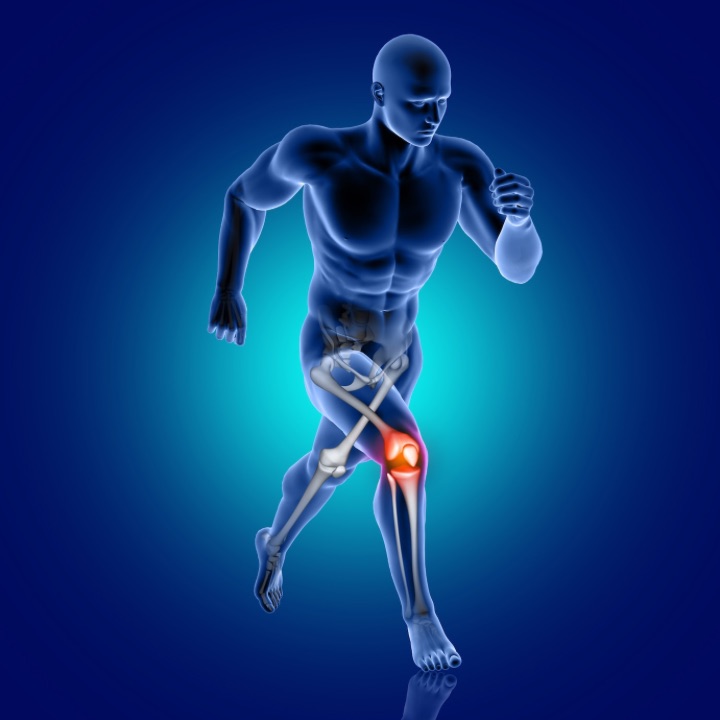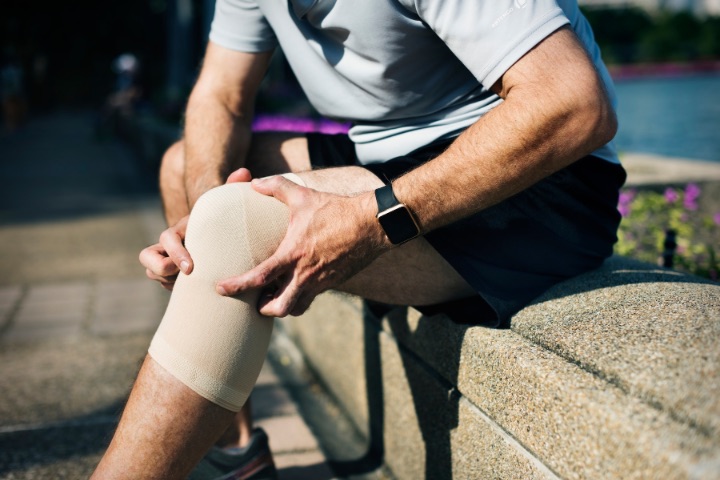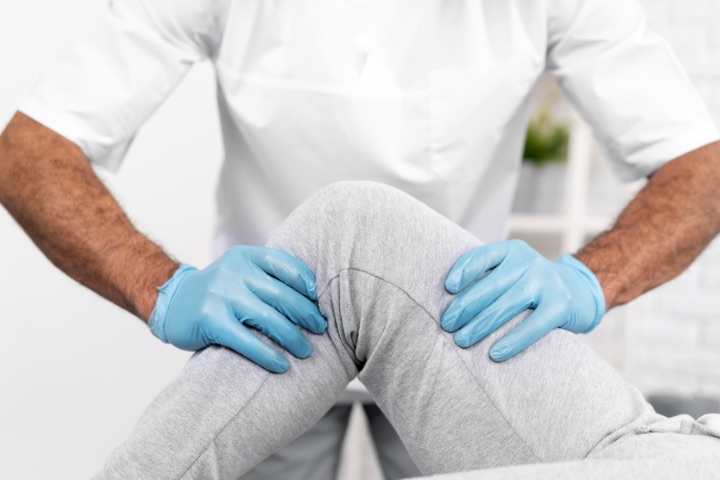What is Patella Dislocation?
The patella, or kneecap, is a small bone at the front of the knee joint. It is crucial in protecting the knee and enhancing its mechanical function. Patellar dislocation occurs when the kneecap moves out of its normal position, often due to a sudden twist or direct impact. This condition can cause severe pain, swelling, and difficulty in moving the knee.
Causes of Patellar Dislocation
A variety of factors can trigger patella dislocation:
- Trauma: A sudden, forceful impact to the knee can cause the patella to dislocate. This could be a direct blow to the knee, such as during a fall or collision, or a sudden change in direction while the foot is planted, which puts excessive strain on the knee joint and the lateral collateral ligament.
- Weak Quadriceps: The quadriceps muscle at the front of the thigh plays a crucial role in stabilising the patella. The tibial tubercle (bony part) attaches the patellar tendon to the quadriceps muscles. It helps keep the patella in its proper position within the femur groove (thigh bone). If the muscle is weak or underdeveloped, it may not be able to hold the patella securely, increasing the risk of dislocation.
- Structural Abnormalities: Certain anatomical features can predispose an individual to patella dislocation. For instance, some people have a high-riding patella (also known as patella alta), where the kneecap sits higher than normal. Others may have a shallow or flat femoral groove, the path along which the patella moves. These structural abnormalities can make the patella more unstable and prone to dislocation causing knee pain.
- Previous Dislocations: Once you’ve had a patella dislocation, you’re at a higher risk of experiencing subsequent dislocations. This is because the initial dislocation may damage the structures that hold the patella in place, making them less effective.
- Sports Participation: Engaging in high-impact sports or activities that involve a lot of jumping and changing direction can increase the risk of patella dislocation. These movements can put a lot of stress on the knee, potentially leading to dislocation.
Symptoms of Dislocated Patella

Photo Credit: kjpargeter, Freepik
The symptoms of patella dislocation can vary, but they often include:
- Acute Pain: This is usually immediate and intense.
- Swelling: Knee effusion may appear within seconds of dislocation.
- Visible Deformity: The kneecap may look out of place or tilted.
- Difficulty Walking: It may be hard to walk or straighten the knee.
Diagnosing Patella Dislocation
Diagnosing a patella dislocation involves several steps:
- Physical Examination: A healthcare professional will conduct a thorough physical examination of the knee to check for subluxation. This may involve checking for visible deformities near the trochlear groove, swelling, and assessing the range of motion in the knee.
- Medical History: The healthcare professional will also take a detailed medical history. This includes asking about any previous knee injuries, the circumstances leading up to the current injury, and any symptoms experienced.
- Imaging Tests: Imaging tests may be used to confirm the diagnosis and assess the extent of the injury. These can include:
- X-rays: These can show if the patella is out of place and also the position of the medial femoral and lateral femoral condyle which if is shallower than the trochlear groove can cause extension of knee, PFPS and dislocation of the patella.
- MRI: This can provide a more detailed image of the knee and can help identify any damage to the soft tissues, such as articular cartilage and other ligaments and tendons.
Treatment and Rehabilitation Options for Patella Dislocation
The treatment for patella dislocation is tailored to the individual’s needs, taking into account the severity of the dislocation, the patient’s overall health, and their lifestyle.

Photo Credit: rawpixel, Freepik
Here are some common treatment options:
- Immediate Care: The first step in treating a patella dislocation is to provide immediate care. This typically involves:
- Pain Relief: Over-the-counter pain relievers may be used to manage the initial pain for first-time dislocations. In some cases, stronger pain medication may be prescribed by a healthcare professional for acute dislocation.
- Reduction: This is a procedure where the patella is put back into place by a healthcare professional manually. This is usually done under local or general anesthesia and is called the reduction of the dislocation.
- Immobilization: The knee may be immobilized using a brace or cast to allow the injured structures to heal. The brace may be enough in certain cases of recurrent instability within the knee.
- Physiotherapy: Physiotherapy is often recommended once the initial pain and swelling have subsided. This can include:
- Strengthening Exercises: These exercises target the muscles around the knee, particularly the quadriceps, to improve stability and prevent future dislocations.
- Range of Motion Exercises: These exercises help restore normal movement to the knee.
- Balance and Coordination Training: These exercises can help improve your ability to perform daily activities and reduce the risk of falls.
- Surgery: In cases where there are associated injuries, such as fractures or significant ligament damage, or if the patella dislocates repeatedly, surgery may be required. The type of surgery will depend on the specific injuries. It may involve repairing or reconstructing damaged ligaments, reshaping the contours of the patella or femoral groove, or in some cases, relocating the attachment of the patellar tendon.
Physiotherapy for Patella Dislocation
The role of physical therapy is a crucial role in the recovery from traumatic patellar dislocation.

Photo Credit: Freepik
It can help:
- Reduce Pain and Swelling: Techniques such as ice therapy, massage, and electrical modalities like TENS (transcutaneous electrical nerve stimulation) can help manage pain and reduce swelling.
- Improve Mobility: Physiotherapists can guide patients through a series of gradual exercises designed to restore the range of motion in the knee from horizontal movements to laterally flexing the knee. This can help patients return to their normal activities more quickly.
- Strengthen the Knee: Physiotherapy can also include specific exercises designed to strengthen the muscles around the knee. Strengthening these muscles can help stabilize the knee and prevent future dislocations.
Preventing Patella Dislocation
Preventing patella dislocation involves several strategies:
- Regular Exercise: Regularly performing exercises that strengthen the quadriceps and other muscles around such as vastus medialis above the knee can help keep the patella stable.
- Appropriate Footwear: Wearing shoes that provide good support and fit well can help prevent injuries that could lead to a patella dislocation.
- Safe Exercise Techniques: Learning and using safe techniques during physical activity can help prevent injuries. This includes warming up before exercise, stretching, and avoiding sudden changes in direction.
- Use of Protective Gear: If you’re involved in high-risk sports or activities, using protective gear like normal knee pads can help protect your knees from injury.
FAQs
What is patella dislocation?
Patella dislocation occurs when the kneecap (patella) moves out of its normal position in the joint.
What causes patella dislocation?
Patella dislocation can be caused by direct trauma to the patella, ligamentous laxity, or other factors that lead to recurrent dislocation.
What are the symptoms of patella dislocation?
Symptoms of patella dislocation include sudden, severe pain, swelling, difficulty bending, straightening or extending the knee, and in the case of acute patellar dislocation case a visible knee deformity.
How is patella dislocation diagnosed?
Patella dislocation is diagnosed through a physical examination of the knee, which may include assessing the stability of the patella and checking for any associated injuries. Imaging tests such as X-rays or MRI may also be done to confirm the diagnosis. If there is acute pain, immediately emergency department should be sought out.
What is the treatment for patella dislocation?
The treatment for patella dislocation depends on the severity of the injury. In some cases, conservative management with rest, ice, compression, and physical therapy exercises may be sufficient. In other cases, surgical management, such as a patellar reconstruction, may be necessary to stabilize the kneecap and prevent further dislocations.
Can patella dislocation recur?
Yes, patella dislocation can recur, especially if the initial injury is not properly treated or if there is underlying instability in that part of the knee. Recurrent dislocations occur if proper caution is not taken after the first dislocation.
What is the role of the patellofemoral ligament in patella dislocation?
The patellofemoral ligament, particularly the medial patellofemoral ligament, plays a crucial role in preventing patella dislocation. Damage or laxity in this ligament can contribute to instability and recurrent dislocations.
What are some complications of patella dislocation?
Complications of patella dislocation can include cartilage damage, loose bodies in the joint, and recurrent patellar instability.
How long does rehabilitation take after patella dislocation?
The time for recovery after patella dislocation can vary depending on the severity of the injury and the individual’s response to treatment. It may take several weeks to several months to fully recover and regain strength and stability in the knee.
Can a knee brace help prevent patella dislocations?
Yes, a knee brace can be used to provide support and stability to the knee and help prevent patella dislocations, particularly in individuals with a history of instability or recurrent dislocations.


